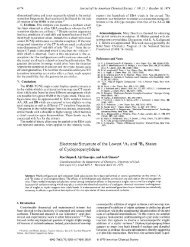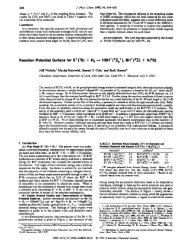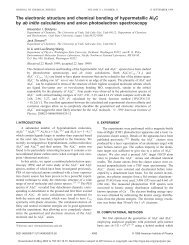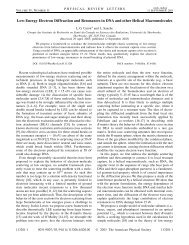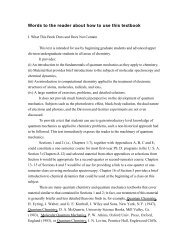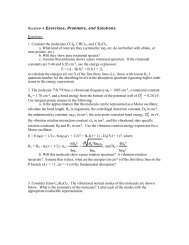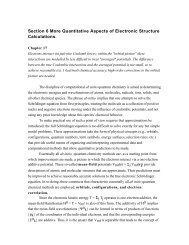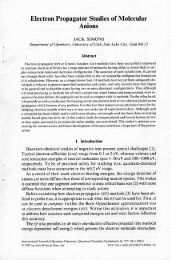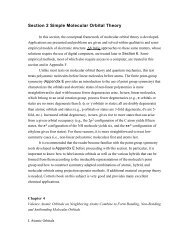Vertical and adiabatical ionization potentials of MH-K+1 anions. Ab ...
Vertical and adiabatical ionization potentials of MH-K+1 anions. Ab ...
Vertical and adiabatical ionization potentials of MH-K+1 anions. Ab ...
You also want an ePaper? Increase the reach of your titles
YUMPU automatically turns print PDFs into web optimized ePapers that Google loves.
<strong>Vertical</strong> <strong>and</strong> <strong>adiabatical</strong> <strong>ionization</strong> <strong>potentials</strong> <strong>of</strong> <strong>MH</strong>k+, <strong>anions</strong>. <strong>Ab</strong> inifio<br />
study <strong>of</strong> the structure <strong>and</strong> stability <strong>of</strong> hypervalent <strong>MH</strong>k+, molecules<br />
Alex<strong>and</strong>er I. Boldyrev <strong>and</strong> Jack Simons<br />
Department <strong>of</strong> Chemistry, The University <strong>of</strong> Utah, Salt Lake City, Utah 84112<br />
(Received 5 April 1993; accepted 8 June 1993)<br />
<strong>Vertical</strong> <strong>and</strong> adiabatic <strong>ionization</strong> <strong>potentials</strong> <strong>of</strong> the free <strong>MH</strong>k, t <strong>anions</strong>, where M is a nontransition<br />
atom <strong>and</strong> k is the maximal formal valence <strong>of</strong> the atom M, have been studied by ab initio<br />
methods. Thermodynamic stabilities <strong>of</strong> the corresponding neutral hypervalent <strong>MH</strong>k+ i species<br />
have been calculated as well. LiH, , BeH,; MgH, , BH, , AlH, , <strong>and</strong> SiH, are very stable to<br />
loss <strong>of</strong> the extra electron <strong>and</strong> are stable geometrically at high symmetry structure, except for<br />
SiH, which is not stable thermodynamically. LiH2, NaH,, BeH3, MgH, , <strong>and</strong> BH4 have minima<br />
at C!,, (2B2) structures; however, only BH, is thermodynamically stable to all possible dissociation<br />
asymptotes. The NaHz anion is not <strong>adiabatical</strong>ly electronically stable.<br />
1. INTRODUCTION<br />
Many complex hydride <strong>anions</strong> <strong>MH</strong>I,t, where M is a<br />
nontransition metal element <strong>and</strong> k is the maximal formal<br />
valence <strong>of</strong> M, are geometrically <strong>and</strong> thermodynamically<br />
stable. <strong>Ab</strong> initio calculations show that LiHT ,l NaH, , <strong>and</strong><br />
KHZ ,I(‘) <strong>anions</strong> have closed shell linear Dmh (‘I%,’ ) structures<br />
[Fig. 1 (a)]; BeH-, -<strong>and</strong> MgH, (Ref. 2) have closed<br />
shell Dsh (‘A;) structures Fig. 1 (b)]; BHC <strong>and</strong> AlH, ,3<br />
have closed shell Td (‘A,) structures [Fig. 1 (c)l; <strong>and</strong><br />
SiHr, GeHF, <strong>and</strong> SnHy ,3 have closed shell D, (‘A;)<br />
structures [Fig. 1 (d)]. The lightest group IV hypervalent<br />
species, CHs <strong>and</strong> CH,, have both been predicted to be<br />
unstable transition states with the radical energetically<br />
more stable than the anion,4’5 <strong>and</strong> the SiHF anion has been<br />
experimentally characterized.6<br />
One <strong>of</strong> the remarkable physical properties <strong>of</strong> these<br />
<strong>MH</strong>F+i <strong>anions</strong> is their very high vertical electron detachment<br />
energies (VEDE) or vertical <strong>ionization</strong> <strong>potentials</strong><br />
(VIP), which recently have been predicted theoretically<br />
using Green function methods.7 For example, BH; <strong>and</strong><br />
AlHz have VEDEs <strong>of</strong> 4.54 eV <strong>and</strong> 4.75 eV,7 respectively.<br />
Both values are higher than the VEDE <strong>of</strong> halide ions (F<strong>and</strong><br />
Cl- have VEDEs <strong>of</strong> 3.40 eV <strong>and</strong> 3.61 eV8). This is<br />
especially interesting, because H-, B-, <strong>and</strong> Al- have a<br />
low electron detachment energies: 0.7542 eV, 0.277 eV,<br />
<strong>and</strong> 0.441 eV*, respectively. The highs VEDEs (or VIPs)<br />
arise because the extra electron in <strong>MH</strong>k+i fills a bonding<br />
HOMO that is delocalized through (k+ 1) hydrogen at-<br />
. oms7<br />
Unfortunately, we were not able to find in the literature<br />
any experimental data on the VEDE or VIP <strong>of</strong><br />
<strong>MH</strong>;+l species. While <strong>MH</strong>F+~ <strong>anions</strong> are very stable to<br />
loss <strong>of</strong> an extra electron, their adiabatic electron detachment<br />
energies (AEDE) or adiabatic <strong>ionization</strong> <strong>potentials</strong><br />
(AIP) are not known. Moreover, the geometric <strong>and</strong> thermodynamic<br />
stabilities <strong>of</strong> corresponding <strong>MH</strong>,, 1 species are<br />
not known. We would like to point out that if <strong>MH</strong>k+l is<br />
stable, the AEDE or AIP is equal to the adiabatic electron<br />
aflinity <strong>of</strong> <strong>MH</strong>k+,. The last values are important for thermodynamic<br />
calculations <strong>of</strong> the stability <strong>of</strong> L+<strong>MH</strong>;+ 1 complex<br />
salts, where L+ is a cation, such as Lif or NH:. Such<br />
complex molecules are known in crystals <strong>and</strong> in solutions’<br />
<strong>and</strong> LiBH,, NaBH4, KBH, have been seen in the gas<br />
phase. lo<br />
The aim <strong>of</strong> this work is to study the geometrical <strong>and</strong><br />
thermodynamic stability <strong>of</strong> <strong>MH</strong>k+ t species <strong>and</strong> to calculate<br />
the AEDEs or AIPs <strong>of</strong> the corresponding <strong>MH</strong>k,, <strong>anions</strong>.<br />
II. COMPUTATIONAL<br />
DETAILS<br />
The geometries <strong>of</strong> LiH, , LiH,, NaHz , NaH,, BeH, ,<br />
BeH,, MgH;, MgH,, BHT, BH4, AIH,, AlH,, SiH;,<br />
SIH,, as well as, LiH, NaH, BeH-, BeH, BeH2, MgH-,<br />
MgH, MgH,, BH,, BH,, BH,, AlH,-, AlH,, AlHs,<br />
SiHc , SiH,, <strong>and</strong> SiH, were optimized employing analytical<br />
gradients’ ’ at the second-order Mtiller-Plesset<br />
[MP2 (full)] level with triple-zeta plus polarization <strong>and</strong> diffuse<br />
bases [denoted 6-3 11 + + G** (Ref. 12)]. The fundamental<br />
vibrational frequencies, normal coordinates, <strong>and</strong><br />
zero point energies (ZPE) were calculated by st<strong>and</strong>ard FG<br />
matrix methods. Finally, higher quality correlated total<br />
energies were evaluated in the frozen core approximation<br />
both by fourth-order MQller-Plesset perturbation theory13<br />
(MP4), <strong>and</strong> by the quadratic configuration interaction including<br />
singles <strong>and</strong> doubles with approximate triples<br />
QCISD(T)14 method using 6-3 11 + + G( 2df,2pd) basis<br />
sets. For open-shell species, the unrestricted USCF wave<br />
functions were projected to produce pure spectroscopic<br />
states (whose results, in turn, are labeled PUSCF, PMP2,<br />
PMP3, <strong>and</strong> PMP4).t5 The Gaussian 92 program suite16<br />
was used to obtain all <strong>of</strong> the results discussed here. In this<br />
article, we report our geometric parameters <strong>and</strong> vibrational<br />
frequencies at the MP2 (fu11)/6-3 11 + + G** level <strong>and</strong> find<br />
energies at the QCISD (T)/6-3 11 + + G( 2df,2pd) level<br />
but at the MP2 (full) /6-3 11 + + G** geometry.<br />
Ill. RESULTS AND DISCUSSION<br />
LiHF , LiH,, NaHz , <strong>and</strong> NaH,. Both LiHl <strong>and</strong><br />
NaH; have stable linear Dmh structures with lo$o2 valence<br />
electronic configurations. The calculated geometric<br />
parameters, vibrational frequencies, <strong>and</strong> relative energies<br />
are presented in Tables I <strong>and</strong> II, <strong>and</strong> in Figs. 1 (a) <strong>and</strong><br />
l(b).<br />
4626 J. Chem. Phys. 99 (6), 15 September 1993 0021-9606/93/99(6)/4628/10/$6.00 0 1993 American Institute <strong>of</strong> Physics<br />
Downloaded 23 May 2003 to 155.101.19.15. Redistribution subject to AIP license or copyright, see http://ojps.aip.org/jcpo/jcpcr.jsp
A. I. Boldyrev <strong>and</strong> J. Simons: Ionization <strong>potentials</strong> <strong>of</strong> <strong>MH</strong>F+, 4629<br />
(4<br />
UH2 (Cm. Qw<br />
,<br />
-9H.c(Td,‘A,) W (Td. 2A~)<br />
”<br />
$ 46.8~<br />
ZII, A A<br />
w<br />
Q<br />
(e)<br />
BHq<br />
(Czv, *a~)<br />
0th<br />
(‘2.. *A’)<br />
NaHr KM,, ‘I&+)<br />
Nab (Lb,, *&+)<br />
Ah-<br />
CTd, ‘Ad<br />
AlHa (Td, *Ad<br />
NJHZ (Cw.<br />
2Sz)<br />
NaHz KU,<br />
*Eu+)<br />
04<br />
BsHs- &he ‘AI’)<br />
SeHg (Cw. 2Sz)<br />
SiHS Pm, ‘Al’)<br />
SlHs<br />
PLV,.~AI’)<br />
sew,<br />
CTSP, C..‘W<br />
SiHs (Ds,. 2Az”)<br />
(9)<br />
WJHC (Dm ‘Al’)<br />
W% (Da,, *A,‘)<br />
(4<br />
MgHI (C2”.=w<br />
MgHs USI, C., *A’)<br />
FIG. 1. Calculated geometries at the MP2(fu11)/6-311+ +G** level for h4Hk+,-<strong>anions</strong> <strong>and</strong> <strong>MH</strong>k+l neutrals.<br />
The LiHF aniori is a geometrically <strong>and</strong> thermodynam- These data agree well with earlier predictions + 54.1 kcal/<br />
ically stable species. Our dissociation energy for mol <strong>and</strong> + 5.3 kcal/mol, respectively by Senekowitsch <strong>and</strong><br />
LiH; --f LiH+H- is +54.0 kcal/mol <strong>and</strong> 4 Li- +H2, it Rosmus’(b) at the coupled electron pair approximation<br />
is a +5.1 kcal/mol (both including ZPE correction). (CEPA) with a large basis set. All <strong>of</strong> the dissociation en-<br />
J. Chem. Phys., Vol. 99, No. 6, 15 September 1993<br />
Downloaded 23 May 2003 to 155.101.19.15. Redistribution subject to AIP license or copyright, see http://ojps.aip.org/jcpo/jcpcr.jsp
4630 A. I. Boldyrev <strong>and</strong> J. Simons: Ionization <strong>potentials</strong> <strong>of</strong> <strong>MH</strong>;+,<br />
TABLE I. Calculated molecular properties for LiH,- <strong>and</strong> LiH, .<br />
LiHF (O,I,,‘Zz) LiH2 (C;s2f%) LiH, CD,, .“Zp’ ) LiH2 (D,A,%)<br />
1414 la21b’ I 2 102,lU; 1o$1u;<br />
MP2(ful1)/6-311++G** MP2(full)/6-311+ +G** MP2(full)/6-311+ +G** MP2(full)/6-311++G**<br />
EMa= -8.61779 Em,=--8.56306 EMp2= -8.49690 EMp2= -8.50930<br />
(S*) =0.752 (S*) =0.798 (S2) =0.943<br />
v,(uJ = 1057 cm-’ v,(q) =3101 cm-’ ~~(0~) =997 cm-’<br />
vL(ugg) =990 cm-’<br />
v2(ru) =425 cm-’<br />
v2(a1) =868- cm-’<br />
v2(ru) =348 cm-’<br />
v2(7-ru)=277i cm-’<br />
~~(o~,)=1120 cm-’ v,(q)=1315 cm-’ ~~(0;) = 1377 cm-’ v3(uJ = 1491 cm-’<br />
ZPE=4.33 kcal/mol ZPE=7.55 kcal/mol ZPE=4.38 kcal/mol ZPE=3.55 kcal/mol<br />
QCISD(T)/6-3ll++G(2d2pd) QCISD(T)/6-311++G(2df,2pd) QCISD(T)/6-311++G(2&-,2pd) QCISD(T)/6Jll++G(2df,2#)<br />
GCF= - 8.55965 E puscF= - 8.51822 E PUSCF= - 8.45823 E p,,s,-F= - h48477<br />
EMp2= -8.61428 EPMP2= -8.55598 ..mEpMp2=-8.49223 E PMP2= -8.50930 .<br />
Em,= -8.62629 E PMP3=-8.56266 EPMP, = - 8.49999 E rMp3=-8.51421<br />
EM,,=-8.62998 EPMP4= -8.56455 EpMp4= -8.50439 E PMP4= -8.51828<br />
Eoc,,,(,,=-8.63150 EocISD(T)=-8.56515 EwISD~T~ g - 8.50809 EQCISDtTj= -8.51916<br />
ergies reported in this paper have been obtained without<br />
correcting for, so called, basis set superposition errors<br />
which are expected to be ca. 4-5 kcal/mol. These corrections<br />
should therefore affect our conclusions only for<br />
weakly bound species.<br />
Substitution <strong>of</strong> Li by Na leads to the geometrically<br />
stable, but thermodynamically unstable NaH, anion. Our<br />
calculated dissociation energy for NaHz --) NaH + H- is<br />
+46.9 kcal/mol <strong>and</strong> for + Na- + H, it is - 12.3 kcal/mol<br />
(with ZPE correction). The NaHF ion- is a local minimum<br />
that should have a potential barrier on the Na- +H, dissociation<br />
pathway because the l&b; (in C,, symmetry)<br />
electronic configuration <strong>of</strong> NaH, does not correlate with<br />
the la~2a~ electronic configuration <strong>of</strong> the Na- (‘S) +Hz.<br />
(‘Z: ) asymptote. The HLiH-m <strong>and</strong> HNaH- <strong>anions</strong> are<br />
isoelectronic with linear BeH,, MgHz, BH$ , <strong>and</strong> AlHt<br />
for which it was shown17 that there are large barriers to<br />
. . .<br />
dissociation C,, <strong>and</strong> near C,, cuts. Senekowitsch <strong>and</strong><br />
Rosmus’(b) have found barriers <strong>of</strong> at least 2 eV above the<br />
minimum energy <strong>of</strong> HLiH-.<br />
Our calculated VIPs <strong>of</strong> LiH; are=very large for both<br />
valence states: 3.06 eV (‘I;:) <strong>and</strong> 3.35 eV (2Xl). The VIP<br />
<strong>of</strong> the “2: state agrees well with that (3.10 eV) <strong>of</strong><br />
Senekowitsch <strong>and</strong> Rosmusl(b) obtained at the CEPA level<br />
<strong>and</strong> with the value (2.95 eV) <strong>of</strong> Boldyrev <strong>and</strong> Niessen7<br />
calculated at the Green’s function level (in both cases,<br />
large-basis sets were used). This agreement between three<br />
different methods confirms that our calculated VIP(2zz)<br />
= 3.0 f 0.1 eV for LiH, should be a good guide for experimental<br />
measurement.<br />
-Detachment <strong>of</strong> the extra electron from the HOMO<br />
(la,) <strong>of</strong> LiH, leads to the “2: state <strong>of</strong> neutral LiHz. The<br />
optimized structure <strong>of</strong> the “2: state <strong>of</strong> LiH2 has an imaginary<br />
bending frequency [~~(a,) G277i cm-‘], <strong>and</strong> therefore<br />
is not a local minimum. The total energy <strong>of</strong> 2ZzLiH2<br />
at the geometry <strong>of</strong> the LiH, anion is higher than LiH+H<br />
by 3.0 kcal/mol, <strong>and</strong> higher than Li+H, by 50.5 kcal/mol.<br />
Optimization following the normal mode <strong>of</strong> imaginary frequency<br />
leads to an angular local minimum structure<br />
( C2U,2B2) with electronic configuration laflbi. This structure<br />
is more stable than LiH+H by 21.9 kcal/mol, but<br />
unstable with respect to Li+H2 by 25.7 kcal/mol. How-<br />
-ever at the optimal geometry <strong>of</strong> this C2, (2B2) structure, a<br />
C,, (2A1) state with 1~~2~: electronic configuration lies<br />
lower by 11.3 kcal/mol [QCISD (T)/6-3 11 +<br />
+G(2df,2pd)]. This C2, (2A1) state correlates with the<br />
TABLE II. Calculated molecular properties for NaHc <strong>and</strong> NaH,.<br />
MP2(full)/6-311+<br />
Ehlpz=-163.11685<br />
+G**<br />
vl(ug) =929 cm-’<br />
v2(7rU)=314 cm-’<br />
v3(uu)=885 cm-’<br />
ZPE=3.49 kcal/mol<br />
QCISD(T)/6-311++G(2df,2pd)<br />
EscF= - 162.94273<br />
Em2= - 162.99-602<br />
E MP3= - 163.oOjO7<br />
E MP4= - 163.01199<br />
EQCISDCTj = - 163.01379<br />
MP2(fu11)/6-311+ +G**<br />
EMp2= - 163.07615<br />
(SZ)=O.751<br />
v,(q) =3810 cm-’<br />
v2(al) =529 cm-i<br />
y(b2) =949 cm-’<br />
ZPE=7.56 kcal/mol<br />
QCISD(T)/6-311++G(2df,2pd)<br />
E PuScF=-162.91610<br />
E rAIp2=-162.95115<br />
fPMP, = - 162.95740<br />
E PMP.,= - 162.95916<br />
EwISDCTj = - 162.95994<br />
MP2(fu11)/6-311-t _ +G**<br />
EMpI= - 162.99720<br />
(S*) =0.847<br />
Y, ( us) = 845 cm-’<br />
v2(z-J = 182 cm-’<br />
v3(u,) =967 cm-’<br />
ZPE=3.11 kcal/mol<br />
QCISD(T)/6-311+ +G(2df,2pd)<br />
E pusc;= - 16218561<br />
E PMP2= - 162.87760<br />
EpMp3= T 162.88468<br />
E PM;= - 162.88967<br />
EwISDCTj = - 162,89597<br />
MP2(firll)/6-311+ +G**<br />
EMpz= - 163.02514<br />
(s*) = 1.022<br />
vi(ur) =868 cm-’<br />
~~(77~) =86i cm-’<br />
v3(uJ =3108i cm-’<br />
ZPE= 1.24 kcal/mol<br />
QCISD(T)/6-311+ +G(2@-,2pd)<br />
E PUSCF= - 162.88621<br />
EpMpZ = - 162.90746<br />
E rM,,=-162.91164<br />
EPMP4=- 162.91555<br />
EwISDCTl = - 162.91694<br />
J. Chem. Phys., Vol. 99; No. 6, 15 September 1993<br />
Downloaded 23 May 2003 to 155.101.19.15. Redistribution subject to AIP license or copyright, see http://ojps.aip.org/jcpo/jcpcr.jsp
A. I. Boldyrev <strong>and</strong> J. Simons: Ionization <strong>potentials</strong> <strong>of</strong> <strong>MH</strong>,, 4631<br />
Li( 2S) +H2( ‘X.$ ) asymptote without any barrier, so it<br />
dissociates. The nonadiabatic crossing between the C,,<br />
(‘B2) <strong>and</strong> C2, (2A1) states takes place only 2.4 kcal/mol<br />
above the minimum energy structure <strong>of</strong> the C2, (B2)<br />
state, which is less than the ZPE correction to this structure<br />
[7.55 kcal/mol at MP2(full/6-311+ +G**]. Therefore,<br />
the C,, (2B2> structure is not stable <strong>and</strong> would<br />
quickly dissociate into Li + H2 throughout nonadiabatic<br />
transition onto the C,, (2A,) surface. The adiabatic IP<br />
(“2:) for LiH, may be calculated with respect to the<br />
dissociation products Li+H,, <strong>and</strong> it is only 0.74 eV. This<br />
very large adiabatic correction (2.32 eV> is due to geometric<br />
<strong>and</strong> thermodynamic instability <strong>of</strong> the final neutral state<br />
<strong>of</strong> LiH,.<br />
The detachment <strong>of</strong> an electron from another valence<br />
MO (10s) leads to the 2X$ state with lo,$$ electronic<br />
configuration. This state has a local minimum at Dmh symmetry<br />
(no imaginary frequencies). The geometrical structures<br />
for Lii2 ( Dmh ,22z ) <strong>and</strong> LiH, ( Dmh, ‘Xg’ ) are very<br />
close (the Li-H bond lengths are 1.710 A <strong>and</strong> 1.735 A,<br />
respectively), therefore the difference between the vertical<br />
<strong>and</strong> adiabatic IPs for this state is very small (0.01 eV> <strong>and</strong><br />
a large Franck-Condon factor is expected for this <strong>ionization</strong><br />
process. Our best values for the VIP <strong>and</strong> AIP (“2,‘)<br />
for LiHl are actually the same 3.35 eV.<br />
The NaHz ion is geometrically stable at a D,, ( ‘IZgf)<br />
structure, but thermodynamically it is not a stable species.<br />
This is unlike LiH; , tihere the anion is a thermodynamically<br />
stable species. Our calculated dissociation energies for<br />
NaH; are +46.9 kcal/mol (into NaHf H-) <strong>and</strong> - 12.3<br />
kcal/mol (into Na- +H2, all with ZPE correction). However,<br />
as discussed above for LiH;, on the dissociation<br />
pathway for NaHl (D-J,, ‘X$ ) --t Na- + H2 there should<br />
be a barrier.<br />
Detachment <strong>of</strong> an electron from the lo,-HOMO in<br />
NaH; leads to the geometrically <strong>and</strong> thermodynamically<br />
unstable NaH2 ( 28$) species. The vertical IP ( 28$) <strong>of</strong><br />
NaH, is 2.63 eV which agrees well with the GF calculation<br />
data 2.53 eV.7 Geometry optimization <strong>of</strong> NaH2 (“2: )<br />
within Dmh symmetry gives a structure which has three<br />
imaginary frequencies [v2(rU.,) =86i cm-’ <strong>and</strong> v3(oU)<br />
=3108i cm-‘]. This structure ( Dah,“8,“) lies below the<br />
NaH+H dissociation asymptote by 1.1 kcal/mol, <strong>and</strong> because<br />
it has an imaginary antisymmetric stretch frequency,<br />
it should dissociate without any barrier. However, like<br />
LiH2, the NaH2 species has a local minimum at C2, symmetry<br />
with a 2B2 electronic state. All frequencies are positive<br />
for this structure (see Table II). This local minimum<br />
is stable with respect to dissociation into NaHf H ( +21.7<br />
kcal/mol), but unstable with respect to dissociation into<br />
Na+H2 (-37.7 kcal/mol). However, as in the case -<strong>of</strong><br />
LiH2, this NaH, ( C2u,2B2) local minimum energy is higher<br />
than the 2A1 (1~~2~~) electronic state at the geometry <strong>of</strong><br />
this local minimum (by 30.0 kcal/mol). Therefore the adiabatic<br />
IP (28$) <strong>of</strong> NaHF should be calculated with respect<br />
to the dissociation products Na+H2 <strong>and</strong> this value is<br />
-0.12 eV(!). The NaH; union. is not udiubuticully electronic&y<br />
stable.<br />
The detachment <strong>of</strong> an electron from the log-MO in<br />
NaH; leads to the 2Xz state which is a local minimum at<br />
Dooh symmetry (see Table II), with a vertical IP <strong>of</strong> 3.21<br />
eV. Because the geometries for NaH, (Dooh,‘&!) <strong>and</strong><br />
NaH2 ( D,h,221) are very close, the adiabatic correction<br />
to this IP is. very-small (0.01 eV). This first excited state is<br />
not thermodynamically stable with respect to either<br />
NaH+H (-13.9 kcal/mol), or NafH, (-73.4 kcal/<br />
mol).<br />
In summary, the result <strong>of</strong> our calculations LiHl <strong>and</strong><br />
NaH; have shown that only LiH; anion is a thermodynamically<br />
stable species, while NaHr (<strong>and</strong> we expect**<br />
KH,, RbHz, <strong>and</strong> CsH,) is not thermodynamically stable,<br />
nor electronically stable if we take into account geometric<br />
relaxation.<br />
BeH; , BeHa, MgHr , <strong>and</strong> MgH,. Both BeHc <strong>and</strong><br />
MgH< are known to have planar D3h (‘A;) structures.2<br />
According to our calculations, the BeHF anion is thermodynamically<br />
stable both to dissociation into BeH- +H2<br />
( +49.6 kcal/mol) <strong>and</strong> into BeH2 (this molecule is thermodynamically<br />
stable with respect to dissociation into<br />
Be+ H2 by 34.7 kcal/mol) +H- ( + 60.1 kcal/mol). The<br />
MgH, ion is also thermodynamically stable both to dissociation<br />
into MgH-+H2 .( + 19.9 kcal/mol) <strong>and</strong> into Mg<br />
+ H2 + H- ( + 56.0 kcal/mol) .-The MgH, molecule is not<br />
thermodynamically stable with respect to dissociation into<br />
Mg+H2 (by -3.9:kcal/mol, with ZPE correction), however<br />
complexation<strong>of</strong> this molecule with H- leads to the<br />
thermodynamically stable MgH, anion.<br />
The valence electronic configuration for both <strong>of</strong> the<br />
above <strong>anions</strong> his lui21ei4. Therefore, vertical electron detachment<br />
should lead to two final electronic states 2E<br />
(lui21er3) <strong>and</strong> 2A; (lu;‘le’4). Our best vertical IPs are<br />
3.97 eV (2E) <strong>and</strong> 6.63 eV (2A;) for BeH,, <strong>and</strong> 3.84 eV<br />
( 2E) <strong>and</strong> 5.82 eV (2A;) for MgHy . The first VIPs <strong>of</strong><br />
BeH, <strong>and</strong> MgH, calculated at the PMP4 <strong>and</strong> QCISD (T)<br />
levels agree well with Green function results 3.86 eV<br />
(BeHT ,2E) <strong>and</strong> 3.74 eV (MgH, ,2E) .7 The 2E electronic<br />
state is geometrically unstable for both BeH3 <strong>and</strong> MgH3<br />
species at the D3h structure due to Jahn-Teller distortion.<br />
The D,, (2E) structure <strong>of</strong> BeH3 at the anion geometry<br />
is not thermodynamically stable with respect to dissociation<br />
into BeH +H2 (AE=-~28.4 kcal/mol) or BeH2+H<br />
(AE= - 15.9 kcal/mol). Geometry optimization <strong>of</strong> the<br />
2A1 (C,,) electronic state ( iaflbi2uf) derived from Jahn-<br />
Teller distortion <strong>of</strong> the 2E state leads directly to the dissociation<br />
products BeH,$H without any barrier; this electronic<br />
state correlates with the ground electronic states <strong>of</strong><br />
the dissociation products. Optimization <strong>of</strong> the 2B2 (C2J<br />
(luf2u$b$ component <strong>of</strong> the Jahn-Teller pass leads to<br />
the local minimum C2, (2B2> structure [see Fig. 1 (c), <strong>and</strong><br />
Tables III <strong>and</strong> IV]. This local minimum is more stable than<br />
BeH,+H (by 7.2 kcal/mol), but it is less stable than<br />
BeH+H2 (by 4.0 kcal/mol, with the ZPE correction).<br />
However, both dissociation pathways have barriers: 6.4<br />
kcal/mol [BeH3(TSI)]. for =BeH,-tH <strong>and</strong> 3.0 kcal/mol<br />
[BeH, (TS;)] for BeH +H, i The geometrical structures <strong>of</strong><br />
the saddle points (TS, <strong>and</strong> TS2) for these two reactions are<br />
presented on Fig. 1 (c). Because there are barriers on the<br />
BeH3 ( C2v,2B2> dissociation pathways, this neutral mole-<br />
J. Chem. Phys., Vol. 99, No. 6, 15 September 1993<br />
Downloaded 23 May 2003 to 155.101.19.15. Redistribution subject to AIP license or copyright, see http://ojps.aip.org/jcpo/jcpcr.jsp
4632 A. I. Boldyrev <strong>and</strong> J. Simons: Ionization <strong>potentials</strong> <strong>of</strong> <strong>MH</strong>r+,<br />
TABLE III. Calculated molecular properties for BeH, <strong>and</strong> BeH, .<br />
BeH: (&,,‘A;) Be% (C2,z4) BeH, (T.Sl,C,~A’) BH, (TS2,C,,zA’) Be% ( CZ,~~) BeH3 (h,‘A;)<br />
_<br />
lu;21e’4<br />
lu$21b 1 2 lu’22u’23u’1 lu’22uf23u’1 142a:lb; lu’11e’4 1<br />
MP2(full)/ MP2(full)/ MP2(full)/ MPZ(full)/ MP2(full)/ MPZ(full)/<br />
6-311++G** 6-311++G** 4-311++G** 6-311++G** 6-311++G** 6-311++G**<br />
EMp2= - 16.44427 E MP2= - 16.34702 EMpz=-16.31663 E ,,,=a16.34240 EMp2= - 16.28919 EMp2= - 16.19637<br />
(‘s2> =0.757 (S2) =0.758 (S2) =0.760 (S2) ==0.778 (S2) =0.766<br />
~,(a;) = 1718 cm-’ v,(q) =2216 cm-’ ~,(a’) =2273 cm-’ v,(d)=2237 cm-’ ~,(a,) =4251 cm-’ ~,(a;) = 1586 cm-’<br />
v2(a;) = 869 cm-’ v2(u1) = 1727 cm-’ v2(a’) =2062 cm-’ v2(u’) =1999 cm-’ v2(ul) =2239 cm-’ v2(uz) = 819 cm-’<br />
v3(e’)=1720 cm-’ v3(al)=88A cm-’ v3(u’) =747 cm-’ v3(a’) = 1695 cm-’ v3(u1)=1041 cm-’ v3(e’)= 1884 cm-’<br />
v4(e’) =882 cm-’ v4( b,) = 595 cm-’ v&a’) =&I cm-’ v4(u’) = 1070 cm-’ vb(bl) = 17723’cm-’ v4(e’) =908 cm-’<br />
ZPE= 11.14 kcal/mol vg(b2)=1620 cm-’ v5(u’) ~456J cm-’ ~,(a’) =705i cm-’ vg(b2)=1309 cm-’ ZPE= 11.42 kcal/mol<br />
vg(b2) =552 cm-’ +(a”) =701 cm-’ ~~(a”) 4659 cm-’ ve(b2) =299 cm-’<br />
ZPE= 10.85 kcal/mol ZPE=8.84 kcal/mol ZPE= 10.95 kcal/mol ZPE= 13.06 kcal/mol<br />
QCISD(T)/6- QCISD(T)/6; QCISD(T)/6- QCISD(T)/6- QCISD(T)/6- QCISD(T)/Q<br />
311++WW,‘Q& 311 + +G(df,2$) 3ll++G(2@,2pd) 3-11+ +G(Zdf,2pd) 3ll++Ghff,2pd) 3ll++G(2df,2&)<br />
EscF= + 16.34705 E ,aUSCF=- 16.27134 EPUSCF= i 16.26673 EpUSCF=- !6.26436--- p=y - 16.21585 F= - 16.10804<br />
EMp2= - 16.44370 E pMpz= - 16.34428 EpMP2= - 16.33165 EpMp2= - 16.33964 ,,,,=-16.28932<br />
pm2= - 16.19339~<br />
EMp3= - 16.46169 -p=-16.35782 EPMP3=-16.34425 EPMP3=-16.35335 Ep,,,=-16.30306 EpMp3=-16.21217<br />
EMpa= - 16.46667 PMP4= = 16.36203 EPMP4= - 16.34812 EpMpQ= - 16.35748 EpMp4= - 16.30733 EPMP4= - 16.22003<br />
EQCISDTcTj = - 16.46819 EwrSDcT) = - 16.36323 EwISDcmTj = - 16.34988 EwISDcTj = - 16.35856 EwISDcTj == 16.30837 EQCISD~T~ = - 16.22591<br />
cule may be observable as a temporarily stable species. The<br />
adiabatic IP (‘E) <strong>of</strong> BeH; calculated with respect to the<br />
C,, (2B2) structure is 2.86 eV.<br />
Electron detachment from the second valence la,-MO<br />
<strong>of</strong> BeHF leads to a 2Ai (D& state. This state <strong>of</strong> BeH3 is<br />
geometrically stable (all frequencies are positive), <strong>and</strong> its<br />
optimized geometry is very close to that <strong>of</strong> BeH; . Therefore,<br />
in this case there is little difference between the vertical<br />
IP (6.63 eV) <strong>and</strong> the adiabatic IP (6.59 eV) for<br />
BeHr . Again, a large Fratick-Condon factor is expected<br />
for this <strong>ionization</strong> process. However, this state <strong>of</strong> BeH, is<br />
highly thermodynamically unstable; its dissociation energies<br />
are - 90.7 kcal/mol ( BeH + H2) <strong>and</strong> - 79.5 kcal/mol<br />
(BeH2+H).<br />
The D3h ( 2E) structure <strong>of</strong> MgH3, at the anion geometry,<br />
is even more thermodynamically unstable than in<br />
BeH3. This structure lies above the dissociation products<br />
MgH +H2 by 50.0 kcal/mol, <strong>and</strong> above Mg+H2+H by<br />
18.1 kcal/mol. Again distortion <strong>of</strong> this structure to C,,<br />
symmetry for the 2A1 electronic state leads directly to dissociation<br />
products. However, C,, optimization <strong>of</strong> the ‘B2<br />
electronic state leads to a local minimum [see- Fig; 1 (d)<br />
<strong>and</strong> Table IV] that is not thermodynamically stable with<br />
respect to the dissociation asymptote MgH + H2 ( AE=<br />
-28.0 kcal/mol), but is thermodynamically stable with<br />
respect to MgH2 + H ( AE= f 8.3 kcal/mol). Because only<br />
small barriers are encountered on both dissociation pathways<br />
(1.0 kcal/mol <strong>and</strong> 5.5- kcal/mol, respectively), the<br />
C,, (2B2> structure <strong>of</strong> MgH3 may not exist even as a temporarily<br />
stable species. The adiabatic IP (2E> <strong>of</strong> MgH,<br />
calculated with respect to MgH3 ( C2,,2B2) is 2.89 eV. The<br />
detachment <strong>of</strong> an electron from the lal-MO <strong>of</strong> MgH, 1<br />
TABLE IV. Calculated molecular properties for MgHF <strong>and</strong> MgH3.<br />
MgH, U$‘A;) W% ( Gr2W Mg% (TSLG,2A’) _ WH3 U’3tv24)<br />
lu’21e’4 1<br />
lu;2u21b1 1 2 1~‘~2u’~3u” lu;11e’4<br />
MP2(fu11)/6-311+ +G** MP2(fu11)/6-311+ +G** MP2(fu11)/6-311+ +G** MP2(fu11)/6,311+ +G**<br />
EMp2= -201.51018 E MP2= -201.41177 EMp2= -201.41209 Em2= -201.29053<br />
(S2) =0.756 JS2> =-o-759 (S2) =0.777<br />
~,(a;) = 1392 cm-’ v,(u,)=1691 cm-’ ~,(a’) = 1705 cm-’ ~,(a;) = 1298 cm-’<br />
v2(u;l) = 581 cm-’ y(u,)= 1318 cm-’ v2(a’) = 1491 cm-’ v2(a;) = 481 cm-’<br />
v,(e’)=1311 cm-’ v3(al) = 188 cm-’ v3(u’) = 1258 cm-’ v3(e’) = 1435 cm-’<br />
v,(e’)=613 cm-’ = v,(b,)=381 cm-’ v4(u’) =792 cm-’ v,(e’)=581 cm-’<br />
ZPE=8.32 kcal/mol y5(t2) =1214 cm-’ vs(u’)=410i cm-’ ZPE= 8.3 1 kcal/mol<br />
v&b2)=322 cm-’ v&a”)=344 Cm-‘_<br />
ZPE=7.31 kcal/mol ZPE=.99 kcal/mol<br />
QCISD(T)/6-3ll++G(2df,2pd) QCISD(T)/6-311++G(2df,2pd) QCISD(T)/6-311++G(2df,2&) QCISD(T)/~-~~~++G(~G!~,~&)<br />
&,,=-201.31296<br />
EPUSCF= ;201.23102 E&,= -201.22823 E p,,scF= -201.10263<br />
EMp2= -201.39950 r EpMp2= -201.29914 E pm2= -201.29X75 EPMP2= -201.17858<br />
EMp3= -201.41749 E ,,,,=-201.31266 E ,,p3=-201.31239 E p,p3=-201.19688<br />
EMpa= -201.42279 E PMP4= -201.31712 E PMP4= -201.31691 E pMp4= -201.20517<br />
EQCISDTcTj = -201.42476 Ewso(,,=-201.31864 EQ,,,,(,,=-201.31817 EQCISDcTJ= -201.21250<br />
J. Chem. Phys., Vol. 99, No. 6, 15 September 1993<br />
Downloaded 23 May 2003 to 155.101.19.15. Redistribution subject to AIP license or copyright, see http://ojps.aip.org/jcpo/jcpcr.jsp
A. 1. Boldyrev <strong>and</strong> J. Simons: Ionization <strong>potentials</strong> <strong>of</strong> <strong>MH</strong>k;, 4633<br />
TABLE V. Calculated molecular properties for Bw <strong>and</strong> BH, .<br />
l&$<br />
B&- (Tdr’A,) BH4 ( C2ti2B2) BH, (C,,2A’) BH, U-d,2A;)<br />
l&u21b’ 1 1 2<br />
la~2~/21u~f23u~*<br />
MP2(fu11)/6-311++G** MP2(full)/6-311++G** MP2(fu11)/6-311+ +G** MP2(fu11)/6-311++G**<br />
EMp2=-27.14513 EMp2= -27.03625 EM,,=-27.02062 EMp2= -26.74991<br />
(S2) =0.756 (S’) =0.765 (9) =0.772<br />
~,(a,)=2312 cm-’ vl(ul)=2686 cm-’ v,(u’) =2720 cm-’ vl(ul) =2096 cm-’<br />
v2(e) =1219 cm-’ v2(ul) =2219 cm-’ v2(u’) =2425 cm-’ v2(e) = 1247 cm-’<br />
v,(t,)=2314 cm-’ _~ v,(q)=1429 cm-’ v~(u’) = 1933 cm-’ v3(t2)=2352 cm-’<br />
v,($)=1124 cm-’ v4(ul) = 1028 cm-’ v4(u’) = 1082 cm-’ v4(t2) = 1157 cm-’<br />
ZPE=21.53 kcal/mol v5(u2) =870 cm-’ v,(u’)=981 cm-’ ZPE=21.61 kcal/mol<br />
vs(bl)=2809 cm-’ ~(a’) =741 cm-’<br />
v,(b,)=lOlS cm-’ ~,(a”)=2547 cm-’<br />
vg(b2) =2098 cm-’<br />
vs(u”) = 1180 cm-’<br />
vg(b2)=742 cm-’ ~~(a”) = 1102i cm-’<br />
ZPE=21.38 kcal/mol ZPE= 19.45 kcal/mol<br />
QCISD(T)/6-311+ +G(2df,2pd) QCISD(T)/6-311+ +G(2df,2pd) QCISD(T)/6-31l.++G(2df,2$) QCISD(T)/6-311+ +G(2df,2pd)<br />
ii&= -26.98661 E PUS-.F= -26.90610 E&&= -26.89182 E PUSCF= -26.58836<br />
EMp2=-27.15285 E pMp2= -27.04166 EpMp2 = - 27.02705 E PMP2= -26.75569<br />
EMp,= -27.17423<br />
E ,M,,=-27.06104<br />
E,,,3=.w~27.04637 _ ._ .EpMp3=-26.78408<br />
Ehlp4= -27.18166 EpMp4= --il.06710 - EpMp4= :27.05305 EpMp4= -26.79845<br />
EwISo~T~ = -27.18280 EwIs,,cTj= -27.06812 EwISDcT,= -27.135462 EwISDcTJ = -26.80638<br />
lafl$<br />
leads to a Dsh (‘Al) electronic state, which does not distort<br />
the structure from its planar triangular symmetry. The calculated<br />
vertical <strong>and</strong> adiabatic IPs (2A1) <strong>of</strong> MgH, are 5.82<br />
<strong>and</strong> 5.78 eV, respectively.<br />
BHC, BH4, AlHr, <strong>and</strong> AlH4. Both <strong>of</strong> these <strong>anions</strong><br />
have right tetrahedral Td (‘A,) structures with la~lt~ electronic<br />
configurations.3<br />
According to our highest level correlated calculations,<br />
both <strong>anions</strong> are very stable thermodynamically, geometrically,<br />
<strong>and</strong> electronically [see Fig. 1 (e), <strong>and</strong> Tables V <strong>and</strong><br />
VI)]. The calculated dissociation energies <strong>of</strong> BHT into<br />
BHC +H2, <strong>and</strong> into BH3 +H- are + 87.2 kcal/mol <strong>and</strong><br />
+ 74.1 kcal/mol, respectively. The dissociation energies <strong>of</strong><br />
AlH7 into AlH,- +H, <strong>and</strong> into AlH,+H- are +69.2<br />
kcal/mol <strong>and</strong> +76.2 kcal/mol (all with the ZPE correction).<br />
The vertical IPs ( 2T2> for both <strong>anions</strong> are very high:<br />
4.62 eV (BHT ) <strong>and</strong> 4.83 eV ( AlH; ) which agrees well<br />
with the previous Green function calculations 4.54 eV<br />
(BHT ) <strong>and</strong> 4.75 eV ( AlHz ) .7 The second vertical IPs<br />
(2A1) are much higher in energy: 10.36 eV (BHB) <strong>and</strong><br />
8.64 eV (AlHc).<br />
The detachment <strong>of</strong> an extra electron from the 1 t2-<br />
HOMO for either BH, Xi-AlHr leads to Jahn-Teller distortion.<br />
This question has been very carefully studied in the<br />
literature for BH, (Ref. 19) <strong>and</strong> several valence isoelectronic<br />
species such as CH$, SiH4+, <strong>and</strong> others.20<br />
TABLE VI. Calculated molecular properties for AlHr <strong>and</strong> AJH4.<br />
l&t$<br />
A1I-G (Tc+‘A,) AJH, ( c3m2B2) AH, ( Tci,2A;)<br />
lu:2u21b1 1 2 la; 1t;<br />
MP2(fu11)/6-311+ +G** MP2(fu11)/6-311++G*” MP2(fu11)/6-3 11+ +G**<br />
EMp2= -244.47360 EMp2= -244.35493 EMp2=~-244.14348<br />
(S2) =0.760 (S’) =0.766<br />
v,(q) = 1806 cm-’ vl(ul) =2492 cm-’ vl(ul) = 1673 cm-’<br />
v2(e) =I80 cm-’ v2(u1) =2071 cm-’ v2(e) =I68 cm-’<br />
v~(tz)=1717 cm-’ v3(q) = 1069 cm-’ v3(t2)=.1823 cm-’<br />
v4(t2) =822 cm-’ v4(ul) =589 cm-’ vh(t2) =787 cm-’<br />
ZPE- 15.70 kcal/mol v.Ja2)=911 cm-’ ZPE= 15.78 kcaVmo1<br />
vs(bl)=2111 cm-’<br />
v,(b,) =603 cm-’<br />
v,(q)=1544 cm-’<br />
vg(b2) =473i cm-’<br />
ZPE= 16.28 kcal/mol<br />
QCISD(T)/6-311++G(2df,2pd)<br />
QCISD(T)/6-3ll++G(2d2@)<br />
h&z= - 244.24547 E puscF= -243.91702<br />
EMp2= -244.37431<br />
EpMpl = m-e.. 244.04278<br />
EMp3= -244.39855 E PMP3= -244.07118<br />
EMp4= -244.40537 E PMP4= -244.08339 f<br />
EQCISDtTj = -244.40754 EwISDcTj = -244.09293<br />
J. Chem. Phys., Vol. 99, No. 6, 15 September 1993<br />
Downloaded 23 May 2003 to 155.101.19.15. Redistribution subject to AIP license or copyright, see http://ojps.aip.org/jcpo/jcpcr.jsp
4634 A. I. Boldyrev <strong>and</strong> J. Simons: Ionization <strong>potentials</strong> <strong>of</strong> <strong>MH</strong>;+,<br />
The potential energy surface <strong>of</strong> the BH4 molecule has<br />
been studied at the MP2/6-3 I** level by Paddon-Row <strong>and</strong><br />
Wong. 19(‘) The Czu (2B2) structure [Fig. 1 (c)] was found<br />
to be the global minimum on the potential energy surface.<br />
The C, (2A’) structure Fig. 1 (e)] is a saddle point on the<br />
flexible intramolecular rearrangement from one globalminimum<br />
structure C,, (2B2) into another Ci, (2B2). BH4<br />
has 12 global minima (C2,,2B,> <strong>and</strong> 24 saddle points<br />
(C,,‘A’) on this potential energy surface. The BH4<br />
(C,,,2B2) structure has been found to be thermodynamically<br />
stable both with respect to BHs +H ( + 12.9 kcal/<br />
mol) <strong>and</strong> BH,+H, ( + 14.8 kcal/mol, both at UMP4/6-<br />
31G(df,p)//UMP2/6-3lG**+ZPE)<br />
dissociations<br />
asymptotes.<br />
We optimized geometries <strong>of</strong> BH4 for the C2, ( 2B2) <strong>and</strong><br />
C, (2A’) structures. The first structure is indeed a minimum,<br />
<strong>and</strong> the second is a saddle point on the intramolecular<br />
rearrangement with a barrier <strong>of</strong> 6.54 kcal/mol. BH4 is<br />
thermodynamically stable with respect to dissociation into<br />
BH,+H (+15.0 kcal/mol) <strong>and</strong> into= BH2+H2 (+15.5<br />
kcal/mol, all with the ZPE correction). This neutral species<br />
has been observed experimentally in ESR (electron<br />
spin resonance) spectroscopic studies.19(a)“9(b) The BH4<br />
radical has been generated by radiolysis <strong>of</strong> a powdered<br />
sample <strong>of</strong> NaBH, at 77 K. The observed ESR spectrum<br />
revealed a very large isotropic hyperhne coupling constant<br />
<strong>of</strong> 107 G19(a)*19(b) <strong>and</strong> is consistent with a C,, structure for<br />
BH4. The adiabatic IP (2r2> <strong>of</strong> BHC with a final C2,<br />
(2B2) structure for BH4 is 3-12 eV. The adiabatic correction<br />
to the IP (27’2) reduces from 4.62 eV (<strong>Vertical</strong> IP) to<br />
3.12 eV (adiabatic IP). However, even the adiabatic IP<br />
(2T2) <strong>of</strong> BH, is very high if we take into account that the<br />
boron <strong>and</strong> hydrogen <strong>anions</strong> have low electron detachment<br />
energies (0.277 eV <strong>and</strong> 0.754 eV,’ respectively).<br />
The detachment <strong>of</strong> an extra electron from the 1o1-MO<br />
<strong>of</strong> BH, leads to a T, (2A1) electronic state which, therefore,<br />
does not distort the structure from the its tetrahedral<br />
symmetry. The optimized R(B-H) = 1.290 A bond length<br />
for this BH, (Td,2A1) state is longer than that R(B-H)<br />
= 1.236 A in BHF . This elongation isexpected because the<br />
electron was removed from a bonding lal-MO. The calculated<br />
vertical <strong>and</strong> adiabatic IPs (2A1> <strong>of</strong> BH; are 10.36<br />
<strong>and</strong> 10.24 eV, respectively.<br />
The removal <strong>of</strong> an extra electron from the It,-HOMO<br />
<strong>of</strong> AlK leads to a 2T2 (Td) electronic state that is not<br />
geometrically stable with respect to Jahn-Teller distortion.<br />
The energy <strong>of</strong> AlH4 ( Td,2T2) at the equilibrium geometry<br />
<strong>of</strong> the anion is higher in energy than the dissociation asymptotes<br />
AlH, + H ( 18.9 kcal/mol) <strong>and</strong> AlH2 + H2 (39.8<br />
kcal/mol). We optimized the geometry for the C2, (2B2)<br />
structure [Fig. 1 (f)], which was a global minimum for<br />
BH4. However, this structure for AlH, has one imaginary<br />
frequency (see Table VI) whose normal mode vector leads<br />
to a C, structure. Further optimization <strong>of</strong> AlH4 within C,<br />
symmetry leads directly to dissociation into AlH2+H2.<br />
Therefore, the C,, (2B2) structure is not even a local minimum<br />
for AlH,.<br />
Another low lying C,, (2A1) structure for AlH, has<br />
also been examined. However, optimization in C,, (2A1)<br />
symmetry leads to dissociation into AlH3+H. Therefore,<br />
no local minimum structure for neutral AlH, has been<br />
found. The adiabatic IP (2T2) for AlH, calculated relative<br />
to AlH2+H2 is 3.11 eV. The adiabatic correction to<br />
the vertical IP (2T2> <strong>of</strong> AlHh is 1.73 eV. Detachment <strong>of</strong><br />
an extra electron from the la,-MO <strong>of</strong> AlH, leads to a 2A1<br />
( Td) electronic state, which also does not distort from the<br />
tetrahedral structure. The optimized AlH, ( 2A1, T,) structure<br />
has no imaginary frequencies (see Table VI) <strong>and</strong> its<br />
bond length A1-H is 0.05 k longer than in the anion where<br />
the bonding $-MO is doubly occupied. The adiabatic<br />
geometric correction to the vertical IP (2A1) <strong>of</strong> AlH, is<br />
only 0.08 eV.<br />
SiH, <strong>and</strong> SiH5. The SiH, anion is a local minimum<br />
at a trigonal-bipyramidal D,, (‘A;) structure according to<br />
numerous ab initio calculations.4 However, the isoelectronic<br />
CH; anion is a transition state at the trigonalbipyramidal<br />
structure.5 The explanation <strong>of</strong> the difference in<br />
these geometric stabilities have been proposed in Refs.<br />
4(h)-4(j). We will not consider CH, here because this is<br />
not a geometrically stable species.<br />
SiH< ( Dxh, ‘Ai) is thermodynamically stable with respect<br />
to dissociation into SiH4+H- ( + 15.95 kcal/mol),<br />
but unstable with respect to dissociation into SiH, +H2<br />
( - 11.31 kcal/mol, all at MP4/6-3 1 + + G** + ZPE) (@<br />
While the barrier for dissociation into SiH, +Hz was not<br />
found in the study by Reed <strong>and</strong> Schleyer,4’e’ this barrier<br />
must be significant in view <strong>of</strong> the experimental observation<br />
<strong>of</strong> SiH, by Hajdasz <strong>and</strong> Squires.6’b’ This anion is also<br />
electronically stable with respect to loss <strong>of</strong> its extra<br />
electron.4Ci)‘7 The neutral SiH, ( D3h ,2A;) is not a minimum<br />
where this structure has one imaginary frequency at<br />
the ROHF/6-3 1 + + G **,4(j)J21 level <strong>and</strong> three at the<br />
UHF/6-3 1 + +G** level.4u)<br />
We repeated optimization <strong>of</strong> SiH, ( D3h ,‘A;) at the<br />
MP2 (fu11)/6-3 11 + + G** level <strong>and</strong> found that this structure<br />
is a local minimum [see Table VII, <strong>and</strong> Fig. 1 (g)].<br />
Our dissociation energies for this anion relative to<br />
SiH,+H- <strong>and</strong> SiH,+H, are +21.8 kcal/mol <strong>and</strong> -7.5<br />
kcal/mol (all with the ZPE correction), respectively. The<br />
electronic configuration <strong>of</strong> SiH, (D3h,‘A;) is<br />
la’21e’41a”22a’2 so four different states (2A;<br />
( 1~~21e’41:;22~~); 2A; (l~;~le’~la;‘2u;~); 2E’<br />
( la;21e’31a122a;2); <strong>and</strong> 2A; ( la;‘la~21e’42a;2)) may be<br />
obtained in the vertical detachment <strong>of</strong> an extra electron. At<br />
the Koopmans’ approximation, the vertical IPs are: 2.56<br />
eV (2A;); 6.91 eV (2AF); 7.26 eV (2E’); <strong>and</strong> 13.62 eV<br />
(2A;>. We calculate the first two IPs at a correlated level,<br />
<strong>and</strong> at our highest level, these values are 2.19 eV (2A; ) <strong>and</strong><br />
5.98 eV (2Ag). Our vertical IP from the 2a;-HOMO agrees<br />
well with a Green function calculation 2.02 eV.7<br />
.- .<br />
Our optimized SiH5 ( D3h ,2A; ) structure has one imag-<br />
inary frequency ~~(a;) = 7351’at the MP2(full)/6-311+<br />
-l-G** level, <strong>and</strong> therefore, is not geometrically stable.<br />
This structure is also higher than the dissociation products<br />
SiH4+H by 12.5 kcal/mol <strong>and</strong> higher than SiH3 +H, by<br />
25.6 kcal/moi. Optimization <strong>of</strong> this structure within C,,<br />
(TA1) symmetry leads to SiH,+H without a barrier. The<br />
adiabatic IP (2A;) <strong>of</strong> SiH, should be calculated with re-<br />
J. Chem. Phys., Vol. 99, No. 6, 15 September 1993<br />
Downloaded 23 May 2003 to 155.101.19.15. Redistribution subject to AIP license or copyright, see http://ojps.aip.org/jcpo/jcpcr.jsp
A. I. Boldyrev <strong>and</strong> J. Simons: Ionization <strong>potentials</strong> <strong>of</strong> <strong>MH</strong>F+,, 4635<br />
TABLE VII. Calculated molecular properties for SiH, <strong>and</strong> SiH,.<br />
SW W3h,“Q<br />
SiH, ( D3,, A;)<br />
SiJ% ( 4h A ; 1<br />
~.<br />
la;*1e’410”z2a’* 2 1<br />
la;*le’4la;‘2a’* 1<br />
la;*le’41a”~2a” 2 1<br />
MP2(fu11)/6-311+ +G**<br />
EMpz= -292.03684<br />
vl(a;) = 2060 cm-’<br />
v2(u;) = 1453 cm-’<br />
v,(4) = 1607 cm-’<br />
v4(ag) = 1040 cm-’<br />
vs(a’) =2027 cm-’<br />
vJe’) = 1079 cm-’<br />
q(e’) =557 cm-’<br />
vs(e”)=1244 cm-’<br />
ZPE=22.81 kcal/mol<br />
QCISD(T)/<br />
6-311++G(2df,2pd)<br />
Es,=-291.76905<br />
Emp2= -291.95273<br />
EMp3=-291.98249<br />
&4~4=-291.99121<br />
EwISD~T~=-291.99348<br />
MP2(fu11)/6-311+ +G**<br />
EMp2= -291.82965<br />
(S2) =0.787<br />
~,(a;) = 2283 cm-’<br />
v2(4) = 1093 cm-’<br />
v3(u;) = 1427 cm-’<br />
v4(ul) = 1040 cm-’<br />
vs(e’) =2347 cm-’<br />
v6(e’)~=893 cm-’<br />
v7(e’) =663 cm-’<br />
vs(e”) =603 cm-’<br />
ZPE=21.24 kcal/mol<br />
QCISD(T)/<br />
6-311++G(2df,2pd)<br />
EPUSCF= -291.57559<br />
EPMP2= -291.74445<br />
EPMP3=-291.77464<br />
EPMP4= -291.78742<br />
Ew,SD~T~=~-291.79502<br />
MP2(fu11)/6-311++G%*<br />
EM,,=-291.96305<br />
(S2> =0.800<br />
v1(a1~)=2219 cm-’<br />
v2(a;) = 1617 cm-’<br />
v3(a2u) = 1579 cm-’<br />
v4(ay) =735i cm-’<br />
v5(e’) =225j cm-’<br />
v,Je’) =863~ &I-’<br />
v,(e’)=112 cm-’<br />
vs(e~“)=987 cm-’<br />
ZPE= 19.81 kcal/mol<br />
QCISD(T)j<br />
6-3 11 + + G (2df,2pd)<br />
E,,s,,=-291.71696<br />
EpMpz=-291.87821<br />
EpMp3= -291.90396<br />
Epm4= -291.91312<br />
EPCISD~T~= -291.91373<br />
*<br />
5<br />
I<br />
spect to SiH,+H which gives a value <strong>of</strong> 1.60 eV. However,<br />
the optimized SiH, (D3h,2Al) structure is a local minimum<br />
(see Table VII), whose axial Si-H, bonds are elongated<br />
by 0.255 A <strong>and</strong> with Si-H, bonds shorter by 0.05 1 A.<br />
The adiabatic IP (2AT> <strong>of</strong> SiH< is 5.40 eV.<br />
IV. OVERVIEW<br />
All <strong>of</strong> the <strong>anions</strong> studied here (LiH;~, BeHc , MgH,~,<br />
BHT , AlH, , ~a%d SiH, ) except NaH; are very stable to<br />
loss <strong>of</strong> the extra electron. Their vertical detachment ener-<br />
TABLE VIII. Calculated vertical (IP,) <strong>and</strong> adiabatic (IP,) <strong>ionization</strong> <strong>potentials</strong> (in eV) <strong>of</strong> <strong>MH</strong>k;l <strong>anions</strong>.<br />
Anion<br />
LiH, IP, (D,,, ,‘2:)<br />
IP, (Li+&)<br />
IP, (Dm/,,*x;)<br />
IP, (De/,,Zxzg+)<br />
NaH; IP, ( Dmh ,%Zi )<br />
II’,, W+H2)<br />
IP, (D-h ,+; 1<br />
IP, ( Dm/, ,*xgf 1<br />
BeH, IP, ( D3&*E’)<br />
I%#,-<br />
IP,<br />
(c;LazB2)<br />
IP, (4/0’4)<br />
IPa<br />
W3/,,*-4;)<br />
II-‘, (D,A,*E’)<br />
IP,<br />
( Czla2B2)<br />
IP, (%,2A;)<br />
IPa ( 4/, .‘A; 1<br />
J=Li- II’, (Td>3”2)<br />
IP, (c2rpzB2)<br />
IP” (Td,24)<br />
IP,<br />
(TdP2A1)<br />
Ami-- IP” (Td,zT2)<br />
II-‘, WH,+H2)<br />
IP” (T&f,z4<br />
SiH,<br />
IP,<br />
(T‘f,*Al)<br />
IP, ( Ds,,,2A;)<br />
IP, (SiH3+H2)<br />
IP, (D3/, g2A;)<br />
IP,<br />
U’3/024’)<br />
Koopmans PUSCF PMP2 PMP3 PMP4 QCISD(T) ADC(3)*<br />
3.48 2.04 2.86 3.05 3.04 3.06 _ 2.95<br />
-0.15 0.48 0.65 0.71 0.74<br />
3.71 2.75 3.32 3.44 3.42 3.35<br />
2.76 3.32 3.44 3.42 3.36<br />
3.12 1.52. 2.41 2.63 2.68 2.63 2.53<br />
-0.99 _ -0.40 -0.22 -0.16 -0.12<br />
3.68 2.63 . -- 3.23 i 3.37 3.34 3.22<br />
2.62 3.22 $36 3.33 3.21 ~‘=<br />
4.42 3.12 3.89 4.02 4.02 3.97 3.86<br />
2.06 2.71 2.83 2.85 2.86<br />
7.36 6.54 6.83 6.82. 6.74 6.63<br />
6.50 6.81 6.79 6.71 6.59<br />
4.33 2.88 3.66 3.83 3.82 3.84 3.74 .-<br />
2.23 2.73 2.85 2.88 2.89<br />
6.40 5.75 6.04 6.g3 5.96 = 5.82<br />
5.72 6.01 6.00 ‘. 5.92 5.78<br />
5.19 3.60 4.54 - 4.60 4.61.’ - 4:62 4.54 =<br />
2.19 3.03 - 3.08 3.12 3.12<br />
12.28 10.98 10.90 -1 10.72~ lb.54 10.36<br />
10.84 10.81 10.62 10.43 10.24<br />
5.40 - 4.01 4.76 4.88. 4.88 4.83 4.75 -=<br />
9.75<br />
2.15<br />
9.02<br />
2.96<br />
9.09<br />
3.09<br />
8.98<br />
3.12<br />
8.84<br />
3.11<br />
-8.54 -<br />
8.94 9.02 8.91 8.76 8.56<br />
2.56 P<br />
2.06 ~. 2.16 2.15 2.19 2.02<br />
_ -0.08 0.92 ~-- -1.01 1.04 1.03<br />
6.91 5.76 6.09 6.10 6.03 5.98<br />
5.26 5.67 5.66 5.55 5.40.<br />
‘Data from Ref. 7.<br />
J. Chem. Phys., Vol. 99, No. 6, 15 September 1993<br />
Downloaded 23 May 2003 to 155.101.19.15. Redistribution subject to AIP license or copyright, see http://ojps.aip.org/jcpo/jcpcr.jsp
4636 A. I. Boldyrev <strong>and</strong> J. Simons: Ionization <strong>potentials</strong> <strong>of</strong> <strong>MH</strong>k+,<br />
gies are higher than the electron detachment energies <strong>of</strong><br />
corresponding atomic <strong>anions</strong> H-, Li-, Na-, B-, Al-, <strong>and</strong><br />
Si- (Be- <strong>and</strong> Mg- BiY5 not electronically stable). The<br />
BeHy , MgH< , BHC , <strong>and</strong> AlHQ <strong>anions</strong> have even higher<br />
electron detachment energies than halogen atoms F-<br />
(3.401 eV8) <strong>and</strong> Cl- (3.613 eV8). The origin <strong>of</strong> the high<br />
electronic stability <strong>of</strong> these <strong>anions</strong> has been discussed by<br />
Boldyrev <strong>and</strong> Niessen7 <strong>and</strong> is thought to be because the<br />
extra electron in such <strong>MH</strong>k, i <strong>anions</strong> fill a bonding HOMO<br />
that is delocalized through (k+ 1) hydrogen atoms centers.<br />
Again, except for NaHz, all <strong>of</strong> these <strong>anions</strong> are also<br />
geometrically stable, (e.g., they have all positive frequencies<br />
at high symmetry structures). Except for NaHl <strong>and</strong><br />
SiHF, all <strong>of</strong> the <strong>anions</strong> studied here are stable thermodynamically<br />
to all possible dissociation asymptotes. However,<br />
only SiH, anion has been observed experimentally.6 We<br />
therefore believe that all <strong>of</strong> these <strong>anions</strong> should be species<br />
that may be studied experimentally. Moreover, these <strong>anions</strong><br />
have very high electron detachment energies.<br />
For the first vertical IPs <strong>of</strong> the <strong>MH</strong>;+i <strong>anions</strong> studied<br />
in this work, we obtained very good agreement with results<br />
<strong>of</strong> previous Green function method calculations7 In this<br />
work, we used indirect methods in which the IP is calculated<br />
as a ditference between the total energies <strong>of</strong> the anion<br />
<strong>MH</strong>;+i <strong>and</strong> the neutral <strong>MH</strong>k+, at the geometry <strong>of</strong> anion.<br />
This approach has certain disadvantages. First, in these<br />
calculations, we use the same basis set for both species even<br />
though this basis will not be the same quality for neutral<br />
<strong>and</strong> anionic systems. Second, in correlated calculations on<br />
the open-shell neutrals, we used the unrestricted Hartree-<br />
Fock reference function, which is known to have spin contamination.<br />
If instead, we use the spin-projected energies<br />
for the neutral, our energy is not-SCF-converged. Finally,<br />
the energy convergence in the MP2-MP3-MP4 series may<br />
be slow. Because <strong>of</strong> these potential weaknesses, comparison<br />
<strong>of</strong> our IPs with results from direct Green function methods,<br />
where the IP is calculated as a correction to an orbital<br />
energy, is very important, especially when studying previously<br />
unknown molecules.<br />
Several important consequences follow from Table<br />
VIII. First, vertical IPs (or vertical EDEs) from the<br />
HOMOs <strong>of</strong> all <strong>MH</strong>k,, <strong>anions</strong> do not vary strongly within<br />
the MP2-MP3-MP4 series (the variation is ca. 0.2 eV).<br />
The PMP4 first IPs are close to the QCISD(T) IPs (the<br />
variation is less than 0.05 eV> <strong>and</strong> to Green function<br />
[ADC( 3)] IPs (variation is 0.1 eV, except for SiH, , where<br />
the discrepancy is 0.17 eV). Because <strong>of</strong> the good agreement<br />
between indirectly <strong>and</strong> directly calculated vertical IPs, <strong>and</strong><br />
because two large yet distinct basis sets have been used in<br />
these calculations, we believe that our values are correct to<br />
within 0.2 eV.<br />
While the LiH, , NaH,, BeHs , MgHs , <strong>and</strong> BH, neutral<br />
species have local minima at C,, (2B2> structures, only<br />
BH4 is a thermodynamically stable species at this C2,<br />
(2B2) structure; for this species, experimental study <strong>of</strong> its<br />
photoelectron spectrum may give structural <strong>and</strong> vibrational<br />
information. However, because BH; <strong>and</strong> BH, have<br />
very different geometries, the pertinent Frank-Condon factors<br />
will be rather small. When the extra electron is re-<br />
moved from the MO lying just below the HOMO, all <strong>of</strong> the<br />
neutral <strong>MH</strong>k+i s p ecies studied here have local minima at<br />
the symmetry <strong>of</strong> the anion <strong>and</strong> with bond lengths close to<br />
the respective <strong>anions</strong>. The Frank-Condon factor, in this<br />
case, should be rather large, <strong>and</strong> transitions will be easier<br />
to measure to obtain structural <strong>and</strong> vibrational information.<br />
Note added in prooJ: Dr. R. P. Saxon <strong>of</strong> SRI International<br />
has provided us with information22 on the BH4 molecule<br />
that relates to results reported here.<br />
ACKNOWLEDGMENT<br />
This work was supported by the Office <strong>of</strong> Naval Research<br />
<strong>and</strong> by the National Science Foundation, Grant No.<br />
CHE9116286.<br />
’ (a) H. Preuss <strong>and</strong> G. H. F. Diercksen, Int. J. Quantum Chem. 1, 631<br />
(1967); (b) J. Senekowitsch <strong>and</strong> P. Rosmus, J. Chem. Phys. 86, 6329<br />
(1987); (c) D. G. Musaev <strong>and</strong> 0. P. Charkin, Koord. Khim. 15, 161<br />
(1989).<br />
‘(a) A. I. Boldyrev <strong>and</strong> 0. P. Charkin, J. Struct. Chem. 18,623 (1977);<br />
(b) L. P. Sukhanov, A. I. Boldyrev, <strong>and</strong> 0. P. Charkin, Russ. J. Coord.<br />
Chem. 6, 803 (1980); (c) E.-U. Wurstwein, M.-B. KroghJespersen,<br />
<strong>and</strong> P. v. R. Schleyer, Inorg. Chem. 20, 3663 (1981); (d) A. I.<br />
Boldyrev <strong>and</strong> 0. P. Charkin, Russ. J. Coord. Chem. 8, (1992); (e) F.<br />
Ramondo, L. Bencivenni, <strong>and</strong> V. Di Martino, Chem. Phys. 158, 41<br />
(1991).<br />
3 (a) A. I. Boldyrev, 0. P. Charkin, N. G. Rambidi, <strong>and</strong> V. I. Avdeev, J.<br />
Struct. Chem. 18, 13 (1977); (b) R. Bonaccorsi, E. Scirocco, <strong>and</strong> J.<br />
Tomasi, Theor. Chim. Acta 52, 113 (1979); (c) A. I. Boldyrev <strong>and</strong> 0.<br />
P. Charkin, Russ. J. Inorg. Chem. 25, 58 (1980); (d) Yu. B. Kirillov<br />
<strong>and</strong>-A. I. Boldyrev, Russ. J. Phys. Chem. 58, 1380 (1983); (e) G.<br />
Scholz <strong>and</strong> L. A. Curtiss, J. Mol. Struct. (Theochem) 258,251 (1992);<br />
(f) M. Spoliti, N. Sanna, <strong>and</strong> V. Di Martino, J. Mol. Struct.<br />
(Theochem) 258, 83 (1992).<br />
‘(a) D. L. Wilhite-<strong>and</strong> L. Spialter, J. Am. Chem. Sot. 95, 2100 (1973);<br />
(b) P. Baybutt, Mol. Phys. 29, 389 (1975); (c) F. Keil <strong>and</strong> R. Ahlrichs,<br />
Chem. Phys. 8,384 (1975); (d) N. M. Vitkovskaya, V. B. Mantsivoda,<br />
T. E. Moskovskaya, <strong>and</strong> M. G. Voronkov, Int. J. Quantum.<br />
Chem. 17, 299 (1980); (e) A. E. Reed <strong>and</strong> P. v. R. Schleyer, Chem.<br />
Phys. Lett. 133, 553 (1987); (f) C. Minot, Nouv. J. Chim. 5, 319<br />
(1981); (g) G. Sini, G. Ohanessian, P. C. Hiberty, <strong>and</strong> S. S. Shaik, J.<br />
Am. Chem. Sot. 112, 1407 (1990); (h) P. Maitre, F. Volatron, P. C.<br />
Hiberty, <strong>and</strong> S. S. Shaik, Inorg. Chem. 29, 3047 (1990); (i) M. S.<br />
Gordon, T. L. Windus, L. W. Burggraf, <strong>and</strong> L. P. Davis, J. Am. Chem.<br />
Sot. 112, 7167 (1990); (j) M. T. Carroll, M. S. Gordon, <strong>and</strong> T. L.<br />
Windus, Inorg. Chem. 31, 825 (1992).<br />
’ (a) K. Morokuma <strong>and</strong> R. E. Davis, J. Am. Chem Sot. 94,106O ( 1972);<br />
(b) A. Dedieu <strong>and</strong> A. Veillard, ibid. 94,673O (1972); (c) K. Niblaeus,<br />
B. 0. Roos, <strong>and</strong>, P. E. M. Siegbahn, Chem. Phys. 26,59 (1977); (d) M.<br />
S. Gordon, D. V. Gano, <strong>and</strong> J. A. Boatz, J. Am. Chem. Sot. 105, 5771<br />
(1983); (e) D. Cremer <strong>and</strong> E. Kraka, J. Phys. Chem. 90, 33 (1986).<br />
‘J. D. Payzant, K. Tanaka, L. D. Betowski, <strong>and</strong> D. K. Bohme, J. Am.<br />
Chem. Sot. 98, 894 (1976); (b) D. J. Hajdasz <strong>and</strong> R. R. Squires, ibid.<br />
108, 3139 (1986).<br />
7A. I. Boldyrev <strong>and</strong> W. von Niessen, Chem. Phys. 155, 71 ( 1991).<br />
sH. Hotop <strong>and</strong> W. C. Lineberger, J. Phys. Chem. Ref. Data 14, 731<br />
(1985).<br />
’ (a) R. M. Adams, Boron, Metallo-Boron Compounds <strong>and</strong> Boranes (Interscience,<br />
New York, 1964); (b) E. C. Ashby, R. Kowar, <strong>and</strong> R.<br />
Arnott, J. Am. Chem. Sot. 92, 2181 (1970); (c) E. Wiberg <strong>and</strong> E.<br />
Amberger, i$ydrides <strong>of</strong> the Elements <strong>of</strong> Main Group. I-IV (Elsevier,<br />
Amsterdam, 1971); (d) E. C. Ashby <strong>and</strong> J. J. Watkins, Inorg. Chem.<br />
12, 2493 (1973); (e) E. C. Ashby <strong>and</strong> H. C. Prasad, ibid. 14, 2869<br />
(1975); (f) E. C. Ashby, R. Arnott, <strong>and</strong> S. Srivastava, ibid. 14, 2422<br />
(1975); (g) E. C. Ashby, <strong>and</strong> A. B. Goel, Inorg. Chem. 17,322 (1978);<br />
(h) B. D. James <strong>and</strong> M. G. H. Wailbridge, Prog. Inorg. Chem. 11, 99<br />
J. Chem. Phys., Vol. 99, No. 6, 15 September 1993<br />
Downloaded 23 May 2003 to 155.101.19.15. Redistribution subject to AIP license or copyright, see http://ojps.aip.org/jcpo/jcpcr.jsp
A. I. Boldyrev <strong>and</strong> J. Simons: Ionization <strong>potentials</strong> <strong>of</strong> <strong>MH</strong>c+,-- 4637<br />
(1079); (i) S. Wold <strong>and</strong> 0. Strout, Acta Chem. St<strong>and</strong>. Ser. A 33, 463,<br />
521 (1979).<br />
lo (a) Y. Kawashima, C. Yamada, <strong>and</strong> E. Hirota, J. Chem. Phys. 94,7707<br />
(1991); (b) Y. Kawashima <strong>and</strong> E. Hirota, ibid. 96,246O (1992); (c) Y.<br />
Kawashima <strong>and</strong> E. Hirota, J. Mol. Spectrosc. 153, 466 (1992).<br />
“H. B. Schlegel, J. Comput. Chem. 3, 214 (1982).<br />
“R. Krishnan, J. S. Binkley, R. Seeger, <strong>and</strong> J. A. Pople, J. Chem. Phys.<br />
72, 650 (1980); A. D. McLean <strong>and</strong> G. S. Ch<strong>and</strong>ler, ibid. 72, 5639<br />
(1980); T. Clark, J. Ch<strong>and</strong>rasekhar, G. W. Spitznagel, <strong>and</strong> P. v. R.<br />
Schleyer, J. Comput. Chem. 4, 294 (1983); M. J. Frisch, J. A. Pople,<br />
<strong>and</strong> J. S. Binkley, J. Chem. Phys. 80, 3265 (1984).<br />
13R. Krishnan <strong>and</strong> J. A. Pople, Int. J. Quantum Chem. 14, 91 (1978).<br />
14J. A. Pople, M. Head-Gordon, <strong>and</strong>, K. Raghavachari, J. Chem. Phys.<br />
87, 5958 (1987).<br />
“H. B. Schlegel, J. Chem. Phys. 84, 4530 (1984).<br />
16M. J. Frisch, G. W. Trucks, M. Head-Gordon, P. M. W. Gill, M. W.<br />
Wong, J. B. Foresman, B. G. Johnson, H. B. Schlegel, M. A. Robb, E.<br />
S. Replogle, R. Gomperts, J. L. Andres, K. Raghavacharl, J. S. Binkley,<br />
C. Gonzalez, R. L. Martin, D. J. Fox, D. J. DeFrees, J. Baker, J. J. P.<br />
Stewart, <strong>and</strong> J. A. Pople, GAUSSIAN 92, Revision C (Gaussian, Inc.,.<br />
Pittsburgh, PA, 1992).<br />
t(a) D. O’Neal, H. Taylor, <strong>and</strong> J. Simons, J. Phys. Chem. 88, 1510<br />
( 1984); (b) N. Adams, W. H. Breckenridge, <strong>and</strong> J. Simons, J. Chem.<br />
Phys. 56, 327 (1981); (c) J. Nichols, M. Gutowski, S. J. Cole, <strong>and</strong> J.<br />
Simons, J. Phys. Chem. 96, 644 (1992); (d) M. Gutowski, M. Roberson,<br />
J. Rusho, <strong>and</strong> J. Simons (unpublished); (e) Review: P. B. Armentrout,<br />
Int. Rev. Phys. Chem. 9, 115 (1990).<br />
18M. W. Chase, Jr., C. A. Davies, J. R. Downey, Jr., D. J. Frurip, R. A.<br />
McDonald, <strong>and</strong> A. N. Syverud, J. Phys. Chem. Ref. Data 14, Suppl. Nl<br />
(1985).<br />
I9 (a) M. C. R. Symons, T. &en, <strong>and</strong> C. Glidwell, J. Chem. Sot. Chem.<br />
Commun. 326 (1983); (b) T. A. Claxton, T. Chen, M. C. R. Symons,<br />
<strong>and</strong> C. Glidewell, Faraday Discuss. Chem. Sot. 78, 121 (1984). (c) M.<br />
N. Paddon-Row <strong>and</strong> S. S. Wong. J. Mol. Struct. (Theochem) 180,353<br />
(1988).<br />
“(a) L. B. Knight, Jr., J: Steadman, D. Feller, E. R. Davidson, J. Am.<br />
Chem. Sot., 106,370O (1984); (b) M. N. Paddon-Row, D. J. Fox, J. A.<br />
Pople, K. N. Houk, <strong>and</strong> D. W. Pratt, ibid. 107, 7696 (1985); (c) K.<br />
Takeshita, J. Chem. Phys. 86, 329 (1987); (d) R. F1 Frey <strong>and</strong> E. R.<br />
Davidson, ibid. 88, 1775 (1988); (e) R..Caballol, J. A. Catala, <strong>and</strong>, J.<br />
Problet, Chem. Phys. Lett. 130, 278 (1986); R. F. Frey <strong>and</strong> E. R.<br />
Davidson, J. Chem. Phys. 89, 4227 (1988).<br />
” (a) F. Volatron, P. Maitre, <strong>and</strong>, M. Pelissier, Chem. Phys. Lett. 166,49<br />
(1990); (b) J. Mot, J. M. Rudzinski, <strong>and</strong> H. Ratajczak, J. Mol. Struct.<br />
(Theochem) 228, 131 (1991).<br />
“R. P. Saxon, J. Phys. Chem. (in press).<br />
J. Chem. Phys., Vol. 99, No. 6, 15 September 1993<br />
Downloaded 23 May 2003 to 155.101.19.15. Redistribution subject to AIP license or copyright, see http://ojps.aip.org/jcpo/jcpcr.jsp





